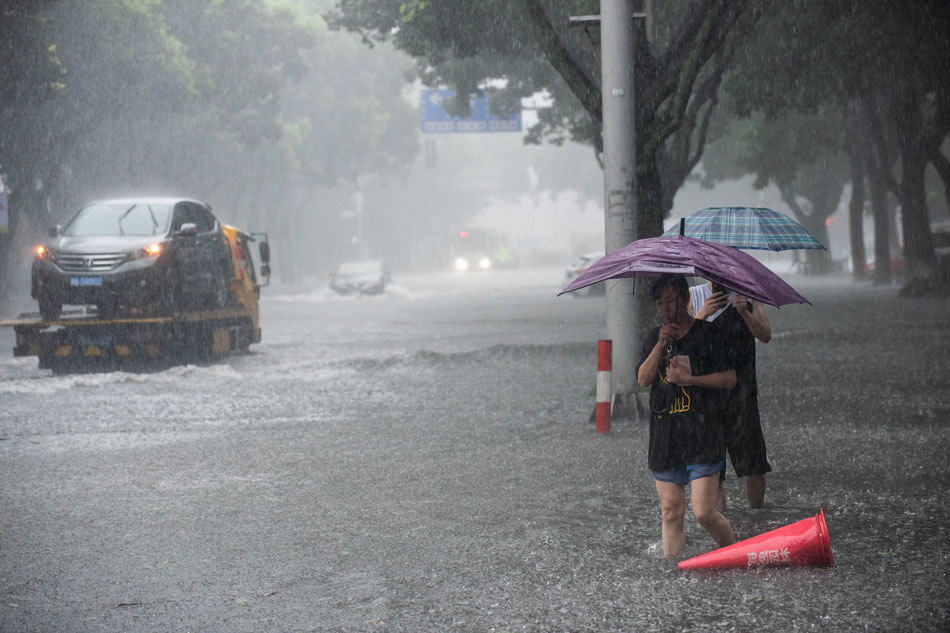Super Typhoon Lekima slams into southeast China | ABS-CBN
ADVERTISEMENT

Welcome, Kapamilya! We use cookies to improve your browsing experience. Continuing to use this site means you agree to our use of cookies. Tell me more!
Super Typhoon Lekima slams into southeast China
Super Typhoon Lekima slams into southeast China
Agence France-Presse
Published Aug 10, 2019 12:48 PM PHT
|
Updated Aug 10, 2019 03:44 PM PHT
SHANGHAI, China - Super Typhoon Lekima slammed into southeastern China early Saturday, bringing torrential rains and heavy winds that knocked out power, downed thousands of trees and forced more than 1 million people from their homes, state media reported.
SHANGHAI, China - Super Typhoon Lekima slammed into southeastern China early Saturday, bringing torrential rains and heavy winds that knocked out power, downed thousands of trees and forced more than 1 million people from their homes, state media reported.
The monster storm made landfall in the early hours in Wenling City packing winds of 187 kilometers per hour, and was expected to churn up the east coast towards Shanghai, Xinhua news agency said.
The monster storm made landfall in the early hours in Wenling City packing winds of 187 kilometers per hour, and was expected to churn up the east coast towards Shanghai, Xinhua news agency said.
More heavy rain was forecast for the Shanghai area as well as the eastern provinces of Anhui, Fujian, Jiangsu and Zhejiang, with authorities warning of possible flash floods, mudslides and landslides caused by the downpours.
More heavy rain was forecast for the Shanghai area as well as the eastern provinces of Anhui, Fujian, Jiangsu and Zhejiang, with authorities warning of possible flash floods, mudslides and landslides caused by the downpours.
In Zhejiang province alone, nearly 300 flights were cancelled, and ferry and rail services were suspended as a precaution.
In Zhejiang province alone, nearly 300 flights were cancelled, and ferry and rail services were suspended as a precaution.
ADVERTISEMENT
More than a quarter of a million people were relocated in Shanghai, where the high-speed maglev train that links the city to one of its airports was suspended.
More than a quarter of a million people were relocated in Shanghai, where the high-speed maglev train that links the city to one of its airports was suspended.
More than 110,000 people were housed in shelters.
More than 110,000 people were housed in shelters.
China issued a red alert as the storm approached on Friday, before downgrading the level to orange as winds eased on Saturday morning.
China issued a red alert as the storm approached on Friday, before downgrading the level to orange as winds eased on Saturday morning.
The storm had earlier swept past the northern tip of Taiwan on Friday, where nine people were injured, thousands of homes lost power temporarily and more than 500 flights were canceled.
The storm had earlier swept past the northern tip of Taiwan on Friday, where nine people were injured, thousands of homes lost power temporarily and more than 500 flights were canceled.
It also caused heavy rains in parts of the Philippines for several days, enhancing the southwest monsoon.
It also caused heavy rains in parts of the Philippines for several days, enhancing the southwest monsoon.
Last September, Typhoon Mangkhut slammed into mainland China where authorities evacuated more than 2 million people, after it left a trail of destruction in Hong Kong and Macau and killed at least 59 people in the northern Philippines.
Last September, Typhoon Mangkhut slammed into mainland China where authorities evacuated more than 2 million people, after it left a trail of destruction in Hong Kong and Macau and killed at least 59 people in the northern Philippines.
ADVERTISEMENT
ADVERTISEMENT



